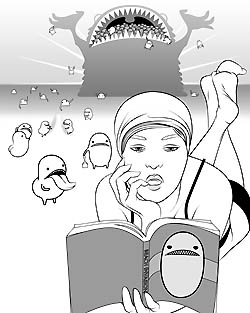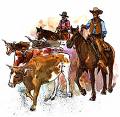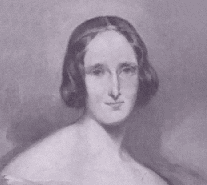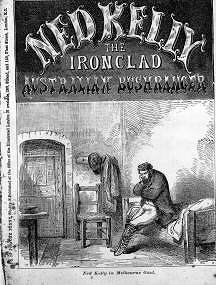|
Irvine Valley College: Online Literature Study of the School of Humanities and Languages Literature 110 - Popular Literature Spring 2013 - Ticket #62740 // Marjorie Coverley Luesebrink, MFA, Instructor
Unit 2c = "Readable" Characters First, let's take a minute to consider this term, "readable characters." Many people criticize genre literature by pointing out that the characters are often "cardboard" or "stereotyped" or "one dimensional." In many cases, this charge is true. We all recognize the "stock" characters from the Western (the noble sheriff, the evil cattle rustler, the pretty, young schoolteacher) or from the Romance (the heroine who has masses of red hair and a slender figure but whose mouth is too wide - so she is loveable to all women).
Our American Cowboys! The books that we will be reading, however, tend to be either seminal examples of the genre (such as *Frankenstein*) or notable re-invigorations in the genre (such as *Harry Potter* or *Gone With the Wind*). In these cases, the exceptional popularity of the book depended on the target audience encountering what would eventually evolve into a stock character - but reading that character for the first time. Readers who did not see these characters as "stereotyped" needed to see them as understandable, recognizable, believable, and entertaining. That is what we might call here a "readable character." When we begin to study some other genres - Western and Romance, for example - we will talk more about "stock" characters and the predictability of their actions. In the case of *Frankenstein*, we actually can see the "creation" of stock characters. That is, Mary Shelley's characters have become simplified and streamlined into almost cartoon characters by now, but in the original novel they are much more complicated - and her contemporary readers would have found her characters new and startling and (as they actually are) a bit complicated!
The Mad Scientist In Mary Shelley's work - Take, for instance, the stereotype of the Mad Scientist. Shelley's portrait of Dr. Frankenstein is far more than the conventional picture we have of The Mad Scientist. He is a legitimate scholar and researcher - even though his ambition carries him far beyond what he can humanly handle, and even though he seems strangely remote from the suffering or danger he might provoke. He is not really mad at all - and in the end he begins to see the enormity of what he has done. Similarly, the Monster, himself, has been streamlined today into a - well, into a scary Monster. But he is anything but in Mary Shelley's work! He starts out his life with no other goal than to find a place in the world - to connect with some kind of humanity. Later, when he is rejected and cast out, his bafflement and anger make him unstable. But he is never a brute and never actively plodding along with an intent to hurt anything. All of the real Monster qualities are added in the many re-cyclings of the story! Even some of the minor or walk-on characters in the book are quite unusual - the Ship's Captain, for example, who provides the "frame for the novel." Strangely enough, although Mary Shelley was the daughter of Mary Wollstonecraft, and was well versed in the Women's Movement of that time, her female characters are staid and conventional - they hardly count in the action of the plot except as victims. {But this would be consistent with the temper of the times - and Mary started out as an Anonymous author, hoping to be seen as male so that her book could gain acceptance.} If you are interested in the life of Mary Shelley - here is a link to my lecture on Mary Shelley in my Women in Literature class. (Scroll through until you get to the Life of Mary Shelley section.)
Mary Shelley
Patterned Structure Patterned Structures in Literature exist at all levels, from the Penny Dreadful to the most sophisticated of novels. Usually, the tighter the pattern, the more predictable the arc of the story, the less likely a piece of writing is considered to be "good literature." But this assumption is faulty in so many cases that I don't recommend that we rely on it for this class. What we want to do is to begin to familiarize ourselves with overall story types so that we can recognize them in Popular Literature (and all literature!).
The Penny Dreadful Paperbacks Frankenstein does have the elements of a patterned story, even though we have by now simplified the pattern so much that it is unrecognizable. In the novel, as you will see, we do have a clear structure. There is a frame that takes place in the Arctic, where Dr. F. tells his story to the sea captain. There is the backstory that Dr. F. tells (the story of his misadventure with the Monster). There is a pattern in the backstory of beginning, middle, and end. I invite all of you to take a close look at this and comment on it in the Discussion Group!
Reassuring Plot By "reassuring plot" I do not mean that everything comes out just fine and roses in the end (although that IS the conventional ending for some genres). Rather, we will consider a plot "reassuring" if it does not break the bounds of audience expectation. The audience, for example, expects that a horror story should involve A. a terrible threat B. the arrival of that threat C. the temporary but not complete elimination of that threat D. a distancing move so that the audience can feel safely removed but not totally free of worry about that threat - it still might lurk "out there." These elements give us the thrill of fear, but do not disrupt our sense of accepted plot scope. They stay within the bounds of the conventions of the Supernatural. [There are books, however, that are NOT in the Horror Genre that are truly horrid and deeply, long-time frightening and disturbming. Sometimes they don't even have anything Supernatural about them! One of these might be J.M. Coetzee's *Waiting for the Barbarians.*] Frankenstein does have the traditional plot elements we have come to expect in a Horror Story - but, of course, almost everyone copied Mary Shelley - so she established these elements. We can talk about these Traditional Plot Elements of Horror Stories on the Discussion List.
continue on to Clear-cut Value System Mythological and Folk Referents Intimacy of Style and Tone
Horror: Mary Shelley is surely the pre-eminent inventor of the horror genre, but Popular Literature is notable for the excellence of the writers in this genre: Bram Stoker, author of Dracula: This site has a discussion of the horror story, biographical information on Bram Stoker, forum for scholars and students, and the complete text of Dracula for you to read! http://www.online-literature.com/stoker/dracula/ Stephen King - a very popular author that many of you may have read - his official website: http://www.stephenking.com/
Marjorie Coverley Luesebrink: write to me with questions!
Marjorie Coverley Luesebrink, MFA, your Instructor, is a Professor of English in the School of Humanities and Languages, Irvine Valley College, Irvine, California. See Online writing at Home Page. |
| MENUBAR: About Your Class // Class Syllabus // Lecture Notes // Reading List // Recommended Reading // Assignments // Grading Policies // Contact Your Instructor // Announcements // Discussion |




